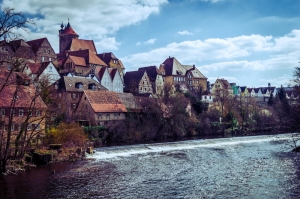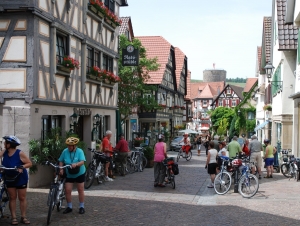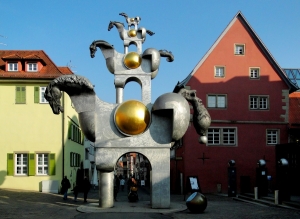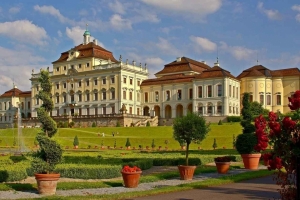Rest in Besigheim
- About Besigheim
- Events
- For tourists
- Leisure
History of the City
In the Middle Ages the idyllic image of Besigheim played a secondary role to its military and strategic importance. In the year 1220 the Margraves of Baden built their fortress with two fortifications in the South and North. From the 15th century onwards Besigheim begin to widely develop winemaking, handicraft production and timber rafting.
At the same time, the city acquired its present form: the church, the Town Hall and the townhouses were built. In 1556 locals took the Protestant faith, and in the first half of the 17century the Thirty Years War (16181648) engulfed Germany, increasing its fragmentation. In the 19th century the city received administrative powers and its own court. Inevitably the main catastrophes of the 20th century were the world wars.
However, in the 50's Besigheim "came alive": active reconstruction of destroyed architectural monuments was carried out, as well as the construction of new buildings, which has not ceased to this day.
Interesting facts
Besigheim is located in the federal state of BadenWurttemberg Approximately 12 thousand people live here. This small and quiet town in the Southern Germany is surrounded by the Neckar and Enz rivers. Its skyline is made up of a varied mixture of gables and roofs, which is interrupted by tall towers and the Baroque town hall, located in the historic centre. The scenic hilly landscape of Besigheim is made up of national parks, which include a wide range of natural features.
The mild valley climate, with an average annual temperature of about 9.5 °C, supports excellent cultivation of fruit and grapes. The city's economy is dominated by income from the sale of wine, and, as a result, by a good harvest.
Attractions
The centre of Besigheim is under state protection. The valuable historical monuments the Town Hall and Market Square with its fountain offer visitors to the town one of the bestpreserved views of medieval Southern Germany.
The most important sights of the city are two medieval towers, the Schochenturm and the Waldhornturm, erected in 1220. The Schochenturm, a 31 metre tall tower, was named in honour of one of the lookouts called Schoch. The second tower – the Waldhornturm – got its name from the Walddhorn Guest House adjoining it, on the top floor of which there used to be an entrance to the tower.
The town church, built in the second half of the 14th century, is a real ornament of Besigheim. The pride of the townspeople is the altar with a height of 13 meters, made from lime wood by Christophe von Urahom in the year 1520.
The City Centre "Stadthalle" is another place that you can visit in Besigheim. Previously the building served a practical purpose: there were special adaptations in it for pressing the grapes. Today it is important from a historical standpoint for its preserved building elements, including basements with huge wooden barrels to store wine, but now it is used as a venue for various events, holidays and festivals.
For art lovers
In the late 19th and early 20th centuries Besigheim became a favourite motif for the landscape artists of Württemberg and became known in artistic circles from Stuttgart to Berlin itself. Such popularity was achieved, first and foremost, through the special location of the city in the river valleys between the Nekkar and the Enz.
Its historic centre with its enchanting medieval beauty was also appealing to the eye of the artist. Among the numerous names of painters, whose creativity is, one way or another, linked to Besigheim, Gustav Schonleber, Professor and Director of the State Academy of Fine Arts in Karlsruhe, and Richard Duschek deserve special attention. The latter, after moving his studio from Berlin to Besigheim, became an active member of the cultural community of the city.
In 2009 year, in honour of the 50 anniversary of the death of Duschek, an exhibition of 133 of his sketches and paintings was held.
The Besigheim Region
For tourists wishing to explore the surrounding area, other towns in the immediate vicinity of Besigheim are worth a visit: Bönnigheim and BietigheimBissingen. BietigheimBissingen is known for its beautiful art gallery, with exhibitions of both classic and contemporary modernism.
Ludwigsburg and its famous Baroque palace
The town of Ludwigsburg is situated not far from Stuttgart. Baroque lovers will be interested in the Ludwigsburg Palace, which is one of the largest palace complexes in Europe. Here there is one of the oldest and most beautiful permanent exhibitions of garden art. Year after year it is visited by more than 500 thousand visitors from all over the world.
Friendly Stuttgart
The proximity of Besigheim to Stuttgart makes a trip to the capital of BadenWuerttemberg an absolute must. The main attractions of this, the sixth largest German city, are: the Old Castle, the Wilhelm Botanic Gardens, the National Gallery and, of course, the MercedesBenz Museum – an incredible architectural initiative from the team of architects at UNStudio.






